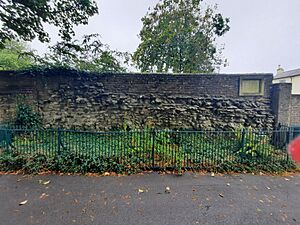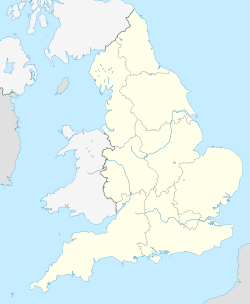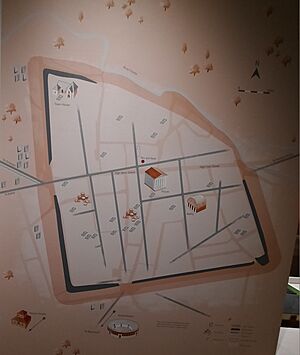Durnovaria facts for kids

Surviving fragment of the town walls of Durnovaria
|
|
| Location | Dorchester, United Kingdom |
|---|---|
| Coordinates | 50°42′54″N 2°26′13″W / 50.715°N 2.437°W |
| Type | Roman city |
| History | |
| Founded | c. 70 AD |
| Abandoned | likely shortly after c. 410 AD |
| Periods | Roman Empire |
Durnovaria was the name of a Roman town in what is now England. Today, this place is known as Dorchester in the county of Dorset. The name Durnovaria comes from an older spelling, Durnonovaria.
Experts believe the name might come from an ancient British language. The first part, *durno-, could mean "fist" or "knob". The second part might relate to a small, enclosed area. Another idea is that the name was originally *Duronovaria. Many ancient British towns with "Duro-" in their name were near river crossings. This fits Dorchester's location perfectly.
Contents
Romans and Maiden Castle
Before the Romans arrived, people in this area lived at a large hill fort called Maiden Castle. It was about 2 miles (3.2 km) southwest of where Dorchester is now.
The people living there seemed to fight against the Roman invasion. Archaeologists found a war cemetery there in the 1930s. Later, in the 4th century, a temple was built at Maiden Castle.
Roman Dorchester: A Busy Town
The area where Dorchester stands today might have started as a small army camp. This camp was for the Legio II Augusta, a Roman army group. It was set up soon after the Romans conquered Britain.
Around AD 70, the army moved away. Durnovaria then became a town for everyday people. It was the main town for the Durotriges, a local tribe. People dug special holes to place items for good luck when building the town.
The Romans planned the town with straight streets. These streets had buildings made of wood. Public buildings, like thermae (Roman baths), were built. They also created a system to bring water into the town.
Durnovaria became one of two main towns for the Durotriges tribe. It was an important place for trade. People traded things like Purbeck marble, shale, and pottery from nearby areas.
The town stayed small at first. But in the 2nd century, it grew towards the northwest. Around this time, town walls were built for protection. Maumbury Rings, an ancient stone circle, was changed into an amphitheatre for shows.
In the 3rd century, wooden buildings slowly started to be replaced with stone ones. This was a bit late for a Roman town. Many rich families had beautiful homes. Their mosaic floors suggest there was a mosaic art school in Durnovaria. Artists from this school likely traveled to create mosaics in other Roman homes nearby.
A large Christian cemetery from late Roman times was found just west of the town. We don't know much about how Durnovaria declined after the Romans left Britain around 410 AD. However, the name of the town lived on. It became Dornwaraceaster in Old English, and then modern 'Dorchester'. People from Dorchester are sometimes called Durnovarians.
What You Can Still See Today
You can still see some Roman parts of Dorchester today. There's a piece of the old town walls. You can also see the foundations of a Roman town house near County Hall. These are open for everyone to visit.
The County Museum has many Roman objects found in the area. The Romans also built an aqueduct to bring water to the town. You can still see parts of it near Whitfield Farm.
Near the town center is Maumbury Rings. This was an ancient earthwork that the Romans turned into an amphitheatre. To the northwest is Poundbury Hill, another old fort from before the Romans.
A piece of a Roman road, now called High West Street, is underneath the Dorset Museum. You can see a part of it inside the museum. This road ran right through the middle of ancient Durnovaria.
The name of the city, Dornwaraceaster, was first written down in the 9th century. It later became Dornaceaster in 937.
Gallery
-
Roman ruins in Dorchester (Durnovaria), Dorset, England (Roman Town House)
-
Excavations at Maiden Castle in October 1937. Photograph by Major George Allen (1891–1940).
-
Burials at the war cemetery at Maiden Castle, which date to the late Iron Age, c. 100 BC - 43 AD
See also
 In Spanish: Durnovaria para niños
In Spanish: Durnovaria para niños









